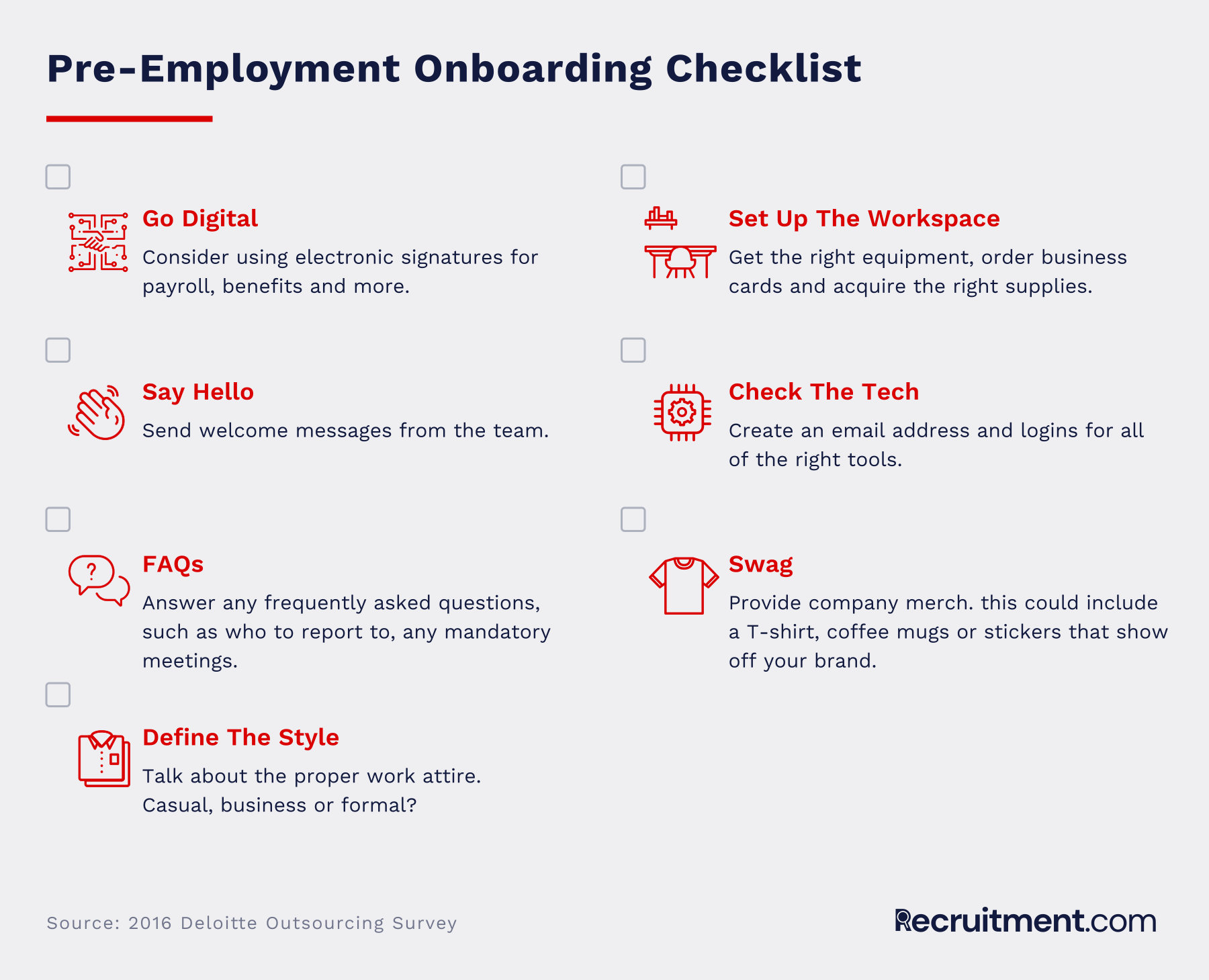The Success Factors For New Employee Onboarding

Josh Spilker is a writer and editor with more than 15 years of experience covering technology, recruiting, and the future of work.
As a recruiter, you may think that once you have the signed offer letter in hand, your job is done. However, onboarding has a significant impact on the trajectory of a worker’s success at a company.
What does the process of onboarding look like at your company?
How would you rate your performance? And how would your new recruits rank you?
The fact is many companies do not onboard well. In fact, one-third of executives also feel that onboarding into new companies is below average. They feel that they onboard well for administrative tasks, but not on more vital ones--such as cultural integration or alignment with objectives.
Why Onboarding Impacts Recruitment
Since onboarding only happens at the beginning of employment, it can seem temporary and unimportant. Consider this: Three in 10 newly hired employees will leave within the first 90 days and the percentage of people switching jobs each year is on the rise.
Successful onboarding impacts the success of recruitment. No one wants to spend the time recruiting, interviewing and negotiating with candidates only to see the one chosen leave three months later.
Then, recruiters will have to start the whole process over again, perhaps even reposting the job and contacting rejected interviewees.
This will drain the recruiter’s time and their emotional reserve as they go out on the hunt again.
So how can your company make onboarding the best it can be?
Good Onboarding Is More Than Orientation
I-9.
Health plans.
401k, life insurance, and dependents.
Very often, onboarding is defined through orientation. Orientation is the paperwork, forms and registration that each employee must complete. After that, it is adjusting to the systems, processes, and software where the skilled work is done.
However, many employees and execs are left to fend for themselves--trying to identify markers of culture, style, and decorum–often with little instruction or help.
Instead, think of onboarding as a longer process to ensure acclimation and integration with your company. A positive beginning will shape their future success and longevity in the role.
Change the mindset
To change from an orientation-driven perspective into onboarding, consider how the HR team will lead in these areas:
- Setting acclimation goals for new employees
- Discussing culture and communication best practices
- Deciding the role of HR with teams and managers in the onboarding process
- Receiving feedback from the new hire
Remember, integration is the goal
According to a Harvard Business survey with more than 500 executives who had moved into new roles, 69% said they had a “poor grasp” of how the organization worked, along with a cultural misalignment.
Integration into the company is important to maximize each employee’s skills.
In another survey from Kronos, almost 60 percent of HR executives said the purpose of onboarding is to integrate employees into the organization’s culture. But only 30 percent of HR executives include culture within onboarding programs.
How much more added value would new hires have if they began contributing business results sooner than later?
What can you do differently to fully integrate members into the fabric of your company?

The 4 Parts of Successful New Employee Onboarding
1. Before the first day
Onboarding should be more than forms and paperwork.
In fact, much of that can be completed before an employee arrives or starts. Most companies believe they have a good feel for these formal procedures. With modern HR tools and software, automation of these tasks is easier than ever.
Taking care of these tasks even before arrival will clear out the first day for more meaningful interactions. The new hire and team can do welcome lunches, team meetings or one-on-one’s with individual members to discuss expectations and to learn about processes.
Thoughtfully introducing a new hire will show that they are cared for, valued and have the opportunity to make a big impact.
Pre-employment onboarding checklist
- Consider using electronic signatures for payroll, benefits and more
- Send welcome messages from the team
- Answer any frequently asked questions (such as who to report to, any mandatory meetings
- Define proper work attire (casual, business, formal)
- Set up their workspace. This involves getting the right equipment, ordering business cards and acquiring the right supplies
- Set up the tech. Create an email address and logins for all of the right tools
- Provide company merch. This could include a t-shirt, coffee mugs or stickers that show off your brand.
2. Provide a cultural overview
It’s time to consider the culture fit. That’s usually discussed in the hiring process, but drops once the new hire begins.
If a large number of executives believe that they had a poor understanding of how the organization worked, along with a minimal understanding of the culture, the feeling is probably mutual with your other hires as well.
What can you do about culture fit?
The HR team at Capital One addressed the culture fit by interviewing all of the managers, bosses and colleagues of the future employee before the new hire began.
The HR team asked not only about what the new employee would be doing but also about any communication habits, challenges and top goals.
With this knowledge in hand, the recruiter or HR onboarding could communicate with the new hire and pass along any memos or notes about what to expect.
"Engaged workers...have bought into what the organization is about and are trying to make a difference. This is why they're usually the most productive workers,”said Jim Harter, the chief scientist of employee engagement at Gallup.
The goal is ongoing employee engagement. Engaged workers are more productive workers and will quickly fit into your culture.
What constitutes culture?
It is not only about diversity, regional differences or big city versus small city.
Culture is also about the decision making process.
Think about the different type of companies your new hire maybe coming from and how that differs (if at all!) from your company.
For instance, a startup may move fast rather than deliberately. New hires from a startup background may perceive that deliberation as part of the unnecessary old guard. However, your company has to balance new ideas while also preserving what works.
What tools and materials could help a new hire understand this difference?
It may be mean discussing styles before or after a meeting, sharing recorded company-wide meetings or other info about what’s important to the CEO and leadership teams.
Culture is not only the job of HR
Teams will need to think about how they want to present new employees to other team members, what key ideas about the company should be discussed (and when) and even have specific discussions to break down the decision-making process and the chain of command.
Also, consider the cultural impact on current employees.
They may need context for what the new hire will do, especially if they share similar responsibilities. This could be detrimental to the whole team if there is disagreement from the start.
Current employees are watching. They are interested in knowing if this company is a long-term fit for them as well, and how internal moves are handled. Onboarding influences all of that.

Cultural overview onboarding
- Communicate challenges
- Break down meetings and communication styles
- Discuss performance expectations
- Share history of the company and the need for the position
- Identify any unforeseen dynamics
- Clarify roles with the existing team
3. Set up peer mentoring
Another way to improve employee onboarding is by assigning a peer to check in and follow up with each new hire. This will immediately create a sense of camaraderie.
This may happen naturally for many employees, but it helps to have a formalized process with new employees.
This assigned peer will help facilitate any office nuances, such as communications, business objectives, and company history.
Most top HR teams don’t employ peer mentoring (only 32 percent) and only 47 percent host key meetings with stakeholders during the onboarding process.
“Organizations make significant investments to source and recruit the best candidates, but often leave these same individuals to find their own way around the organization once they start. HR leaders need to re-evaluate how onboarding programs are structured and deployed within their organizations,” said Jenna N. Filipkowski, Ph.D., head of research, Human Capital Institute after the release of the Kronos study examining onboarding processes.
Why use peer mentoring with onboarding?
Management and onboarding consultant Richard Pimentel suggests these peer mentoring benefits during onboarding:
- Help with the new transition
- Shows commitment to the new employee’s success
- Safe place to bring questions
- Model the type of behavior your company wants to be exemplified
- Identify where skills of the new employee can help the company
Too often the assimilation of new employees is left to the HR department.
These representatives don’t have the complete look of the departmental function and therefore don’t provide the best representation of the company for the new employee.
4. Follow up after 1 month and beyond
Three in 10 newly hired employees will leave within the first 90 days.
It costs up to 33% of a worker’s salary to replace them, considering lost productivity from the departing worker and the amount of time before a new worker can contribute to the company. If the average worker makes $54,000 that could be up to $15,000.
New hires leave within 90 days because of:
- Unexpected day-to-day responsibilities
- A bad experience
- Poor company culture
- Received a better offer elsewhere
How do you keep an employee from leaving so soon? What makes a difference? In reality, it’s following the steps above.
The more ingrained an employee feels from the beginning, the less likely they are to leave that quickly.
Understanding the culture, what will happen in the role and fair compensation from the start helps retain employees even during their initial onboarding process.
This is especially crucial as top leaders feel less and less comfortable with their contributions at the beginning of their tenure at a company. According to Harvard Business Review, most executives feel that it takes six to nine months to offer meaningful contributions in their new roles.
If your team is shuffling through new hires at a rapid pace and can’t seem to get any traction after a few months, that’s a clear sign that your onboarding process is broken.
Conclusion: What Onboarding Objectives Do You Need?
Is it a lot to onboard new employees? Does it seem like too much extra work?
It’s also a lot of work to keep repeating the recruiting process over and over if your new hire leaves.
Michael D. Watkins, the author of The First 90 Days and his team developed an assessment matrix for onboarding new executives. Though geared at top-level executives, many of its principles can be used for most new hires. Here are his recommendations, coupled with the fundamentals. You can use this list to jumpstart your thinking and then create your own onboarding objectives for new hires that fit your company.
Generally, your HR team should cover each of these areas in onboarding.
Onboarding objectives
- Administrative registration: Paperwork, registration and more
- Business background: Key industry insights, history and knowledge
- Compliance: Include any training, legal or procedures here
- Align with stakeholders: Set meetings with key team members and stakeholders. This may include communication, organization and any challenges
- Engage with culture: Pair new employees with a peer mentor, identify any cultural shifts and organizational nuances.
- Define strategic intent and objectives: Help new hires know how their work connects to the larger organization, the strategic business initiatives and productivity expectations.

Josh Spilker is a writer and editor with more than 15 years of experience covering technology, recruiting, and the future of work.






